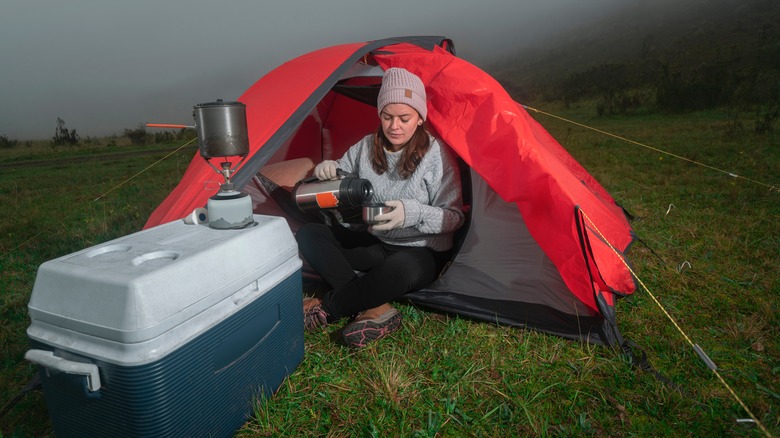Why You Should Add A Layer Of Foam To The Top Of Your Cooler
We all know the feeling: you pack the perfect ice cooler for a camping trip or beach party, only to find a slushy or lukewarm mess when it's time to dig out some deliciousness. Tips abound for perfect ice-chest layering, temperature control, and freezing components. Super-serious cooler fans even advocate spending mega bucks on pro-level portable coolers. But what if you just want an easy, affordable, stress-free way to keep things chilled when eating outside?
First, remember that what goes in your ice chest ends up in your body — and you certainly don't want to ruin that outdoor date with Mother Nature. Even when tucking perishable foods into piles of crushed or blocked ice, they'll potentially go bad as outdoor temps rise and cooler ice turns to water. Bacteria starts creeping and multiplying once cooler temperatures rise above 40 degrees F, according to Our Everyday Life. Once that happens, you've got two hours max to consume the food before it gifts your clan with food-borne illness. WebMD notes that foods spoil within an hour once the heat reaches 90 degrees F.
So, here's one of the most basic tricks for keeping food fresh inside an ice chest: add extra insulation with a simple sheet of foam. Variations on that concept lead to easy, low-cost, outdoor fun.
Chilling out the easy way
Most coolers today come with built-in insulation to help with ice retention, per Best Cooler. But they can only do so much as hours go by and outdoor temperatures increase. That's why DIY enthusiasts recommend adding an extra layer of insulation to the top of your cooler. Flylords Magazine stresses that empty space within a cooler is your enemy, recommending a foam pad as a finishing layer to absorb air space and improve insulation. This can be a simple cut-to-fit sheet of foam from a hardware store or a retrofitted item from around your house. Delish suggests trimming a clean unused yoga mat. Simply place the layer of foam on top of the filled ice chest or tuck it into the lid before closing.
The same technique is adaptable to other accessible materials, such as thermal bubble wrap. Real Simple notes the extra step of lining the bubble wrap with aluminum foil to help reflect UV rays. Home improvement stores make that even easier by selling pre-aluminized bubble wrap, which reflects about 90% of heat radiation, according to Hunting Waterfalls. Double-sided tape keeps it snuggly in place, either in the lid or on interior sides and bottom before adding food and ice. Feeling particularly crafty? Create an exterior reflective cooler cover from the same material.
Other Hunting Waterfalls cooler hacks include hijacking pieces of Styrofoam, plastic, cardboard, or even a cloth towel to keep warm air from reaching your food.

